 |
Although the plants bear tall spikes of white or lavender flowers in midsummer, hosta are planted primarily for the season-long show of their striking foliage. It takes more than good looks, however, to make a plant a world-class winner. Few perennials are truly carefree, but hostas come close. They never need dividing. Once established, they shade the ground so thoroughly that they reliably crowd out most weeds. Hostas are not fussy about soils, and many cultivars even do quite well with considerable sun. It’s no wonder gardeners are planting them in record numbers.
Hosta leaves come in a broad range of solid colors, from blue-gray to deep green to light green or gold. Blue hostas often have a soft, waxy bloom (a powdery-looking coating on the leaves, also found on grapes), especially early in the season. Some green varieties have very shiny leaves; others have a matte appearance. Variegation can be white, cream, or yellow and can occur on the edges of the leaves, in the centers, or streaked throughout the leaf. The most common leaf shape is heartlike, but some cultivars have narrow, straplike leaves. The largest hostas are 3-4 feet tall; the smallest are under 8 inches. Mix all these factors together and you get an idea of why plant breeders are having such fun with this group of plants.
Planting Hostas: Typically, the plant you buy is a one- or two-eye division. The eye is a piece of a stubby underground stem, called a rhizome, containing a single squat, conical bud from which the leaves arise. The many roots that grow from the rhizome are about as thick as heavy twine, something like the roots of daylilies.
New rhizomes form slowly, and a clump may take a few seasons to fill out. However, don’t be tempted to crowd the plants; follow spacing recommendations carefully. You can fill in between the plants with daffodils, Virginia bluebells, or annuals.
 |
 |
 |
||||||
| ‘P. McConnell Allen ‘ Hosta Dark green oval leaves with irregular fine white to creamy margins form a dense, symmetrical mound. |
‘Chantilly Lace’ Hosta ‘Chantilly Lace’, a midsummer bloomer, is a small Hosta with long, narrow medium-gray-green leaves outlined in creamy white. |
‘Blue Ice’ Hosta ‘Blue Ice’ has intense blue-green heart-shaped leaves of a thick, heavily corrugated substance. |
||||||
 |
 |
|||||||
| ‘Climax’ Hosta Hosta ‘Climax’ has heavily corrugated green leaves, each with a 1-inch wide golden border. Each large 4 foot + clump has a vase-shaped habit. |
‘Formal Attire Hosta The leaf is a dark blue-green with a wide cream margin that becomes pure white as the season progresses. |
Where Hostas Grow: Hostas are among the most adaptable perennials. They do well from USDA Hardiness Zone 3 (-40F minimum) southward as far as zone 9 (20F minimum). Hostas need a period of cold weather, at the onset of which they turn a pleasing yellow and then go dormant. Insufficient winter chill and dry air, such as in western deserts, are the chief limiting factors.
Some hostas are native to woodlands and others grow in moist meadows where tall grasses provide some shade. In the garden, one-third shade is ideal. If soil moisture is ample, most hostas can take direct sun, especially in cooler climates and at the northern limit of their range. Gold varieties must have some direct sun for their full color to develop; in shade they become chartreuse. Blue varieties develop best color in shade. When hostas get too much sun or not enough water, the leaf edges become papery and brown. At the southern edge of their range, more shade is beneficial.
Care: A little extra TLC will get new hosta plantings off to a strong start. Be sure to water the plants during dry spells, especially during their first growing season. Apply a 2-inch-thick mulch of compost or leaf mold each year to provide nutrients. Hostas growing in the shade of large trees may need supplemental waterings to help them compete with the tree roots.
The only major pests of hostas are slugs, which thrive in the moist, cool, shady areas that hostas love. Controls include handpicking, traps, and deterrents like a layer of diatomaceous earth or crushed eggshells spread underneath the plants.
Unlike many perennials, hostas do not need regular dividing to keep them growing strong. Established hosta plantings have been in place for 30 years and longer with no need for dividing.
Credit: National Gardening Association




























